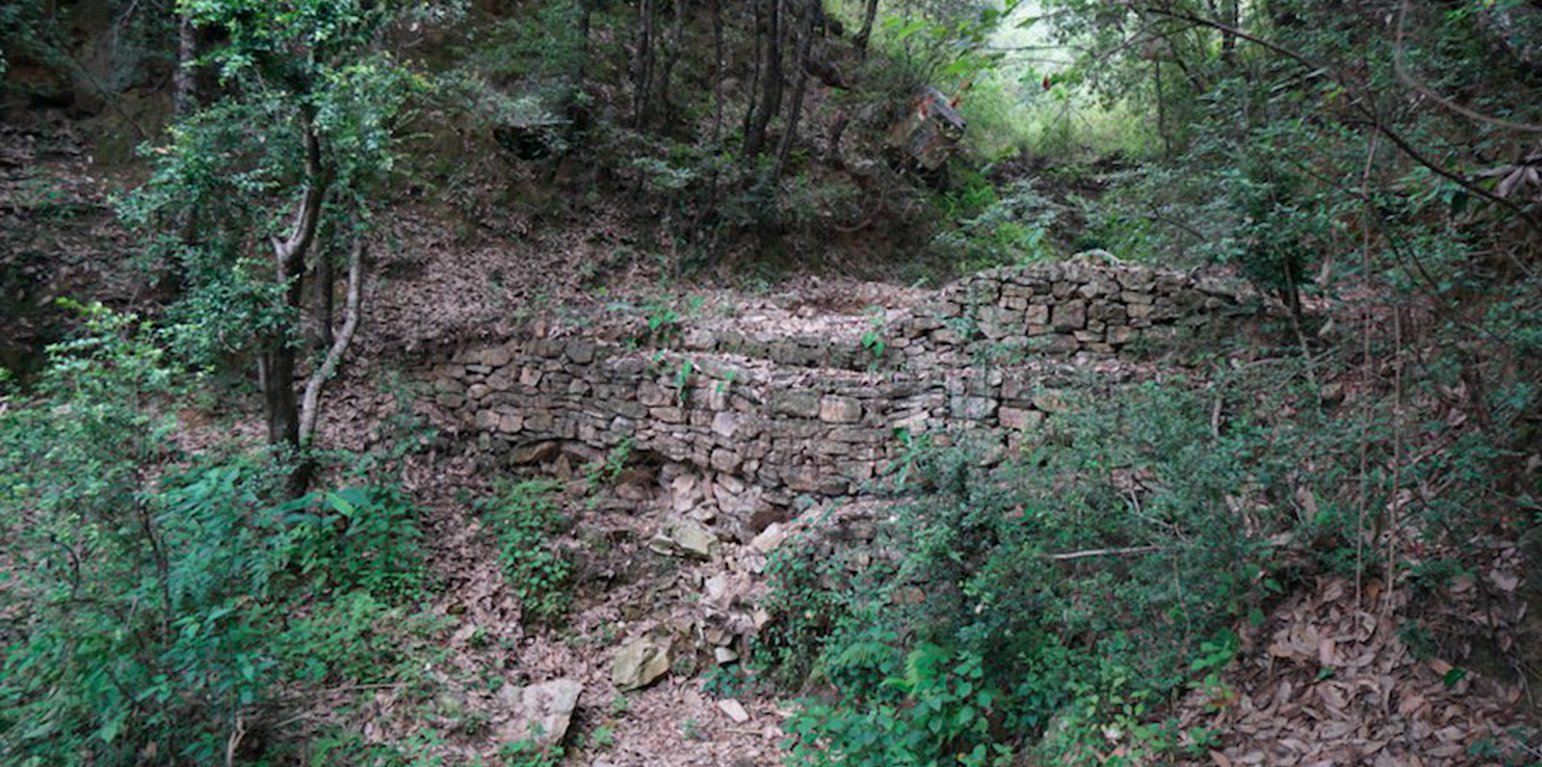



1. The technology is found in both natural and human environments (forest and settlement areas)
2. Main Characteristics: A check dam or check wall is constructed in a loose or active gully or a rill (shallow channel) that threatens to enlarge, or anywhere on a slope where there is a danger of scour from running water. The structures lower the velocity of flow. In Nakina porous check walls, check dams, and retainment walls were made out of stone gathered from the surrounding area. A porous check dam releases a portion of flow through the structure, decreases the head of flow over the spillway, and decreases the dynamic and hydrostatic forces against the check dam. Porous check dams are simple and more economical for construction.
Once stones are collected they are cut into suitable sizes and surfaces ( "dressing" of stones). The site where the technology is to be constructed is then cleared and, for check dams, the sides are sloped 1:1 (this simply refers to the ratio of the rise and run of the slope, so 1:1 means you'll have a 45 degree slope for your excavation). This is also known as the angle of repose, where the granular material of the embankment will be stable and not slump from its own weight. The base of the dam should be around 70 cm thick if it is 1 meter high. The bed of gully is excavated for foundation and dry stones are packed from that level.
3. Purposes/functions: Interrupts the flow of water and flattens the gradient of a channel, thereby reducing the velocity and inducing infiltration rather than eroding the channel. These structures not only slow flow velocity but also to distribute flows across vegetation. Despite some sedimentation resulting behind the dam, small cracks and porous spaces in the holes of the stones allow some sediment to flow through and the finer particles fill the gaps and strengthen the structure. Check dams can also be designed to create small reservoirs.
4. Major activities include identifying the appropriate site of installation, collection of construction materials, technical planning of the structure dimensions and design, manual labor, and maintenance.
5. Benefits/impacts: These structures decelerate runoff and accelerates groundwater recharging by storing water and facilitating infiltration of water into the soil
6. Like/Dislike:
Advantages
•Inexpensive and relatively easy to install given local building materials and labor availability
•Reduce velocity, prevent gully erosion and cause a high proportion of the sediment load in runoff to settle out, preventing downstream damage
•When carefully located and designed, check dams can remain as permanent installations with very minor regrading
Disadvantages
•Many of these structures have a temporary nature, and need to reconstructed or removed after significant damage
•Removal or reconstruction may be a significant cost depending on the size and design
•May kill grass linings in channels if the water level remains high after rainstorms or if there is significant sedimentation.
•May create turbulence which erodes the channel banks.
•Clogging by organic material may be a problem and hinder the structure's function
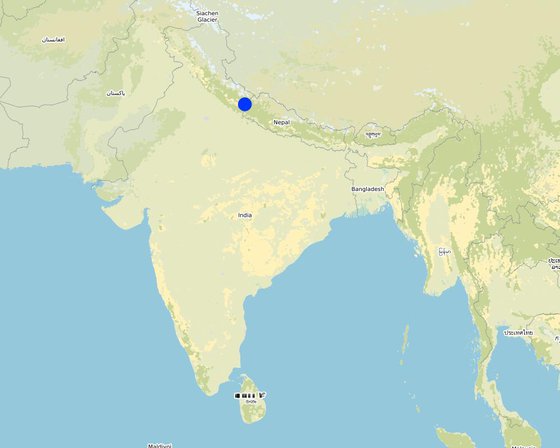
Местоположение: Nakina Village, Pithoragarh Bloc, Uttarakhand, Индия
Число исследованных участков, где применяется Технология: 2-10 участков
Пространственное распространение Технологии: примененяется точечно/ на небольших участках
На постоянно охраняемой территории?: Да
Продолжительность применения Технологии: более 50 лет назад (традиционная)
Тип внедрения/ применения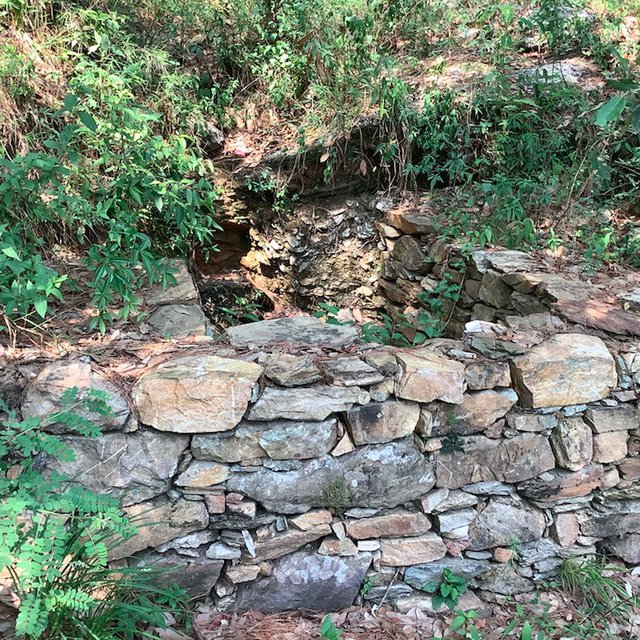
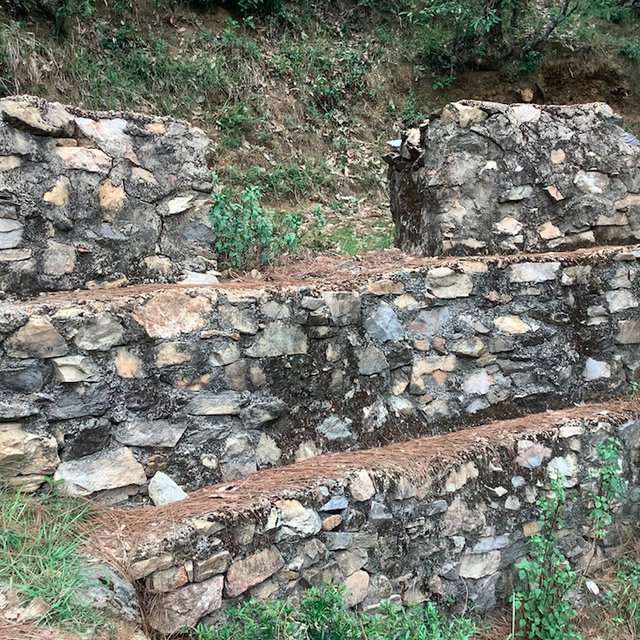

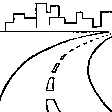





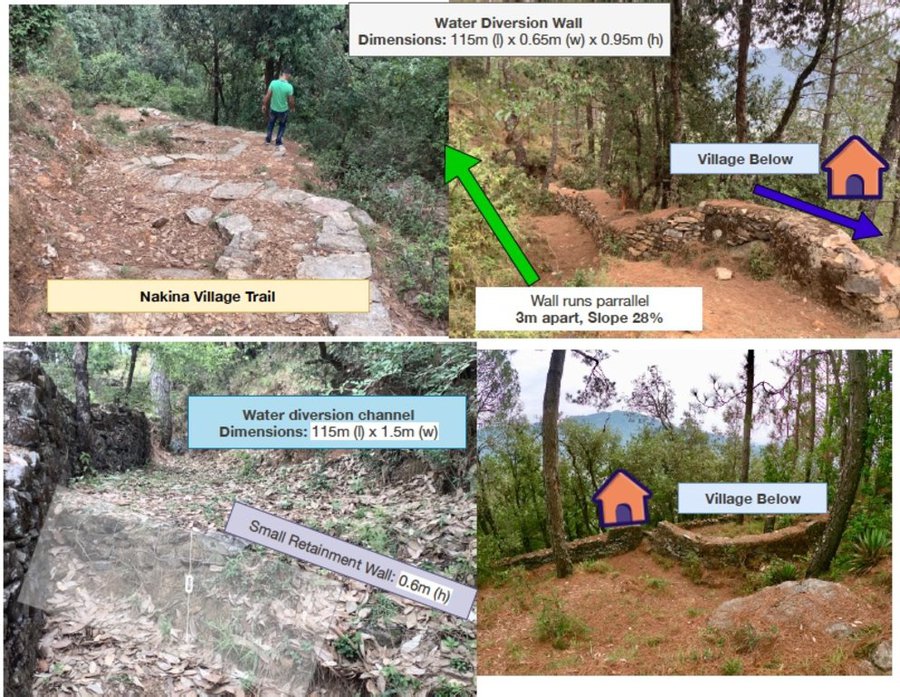
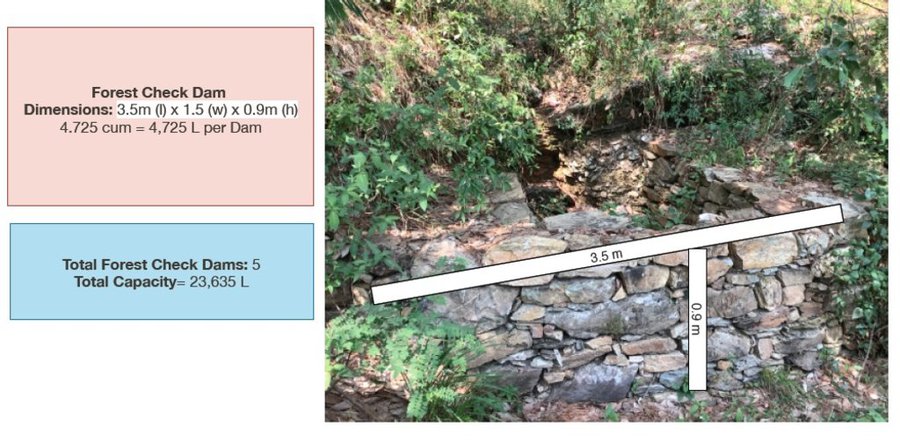
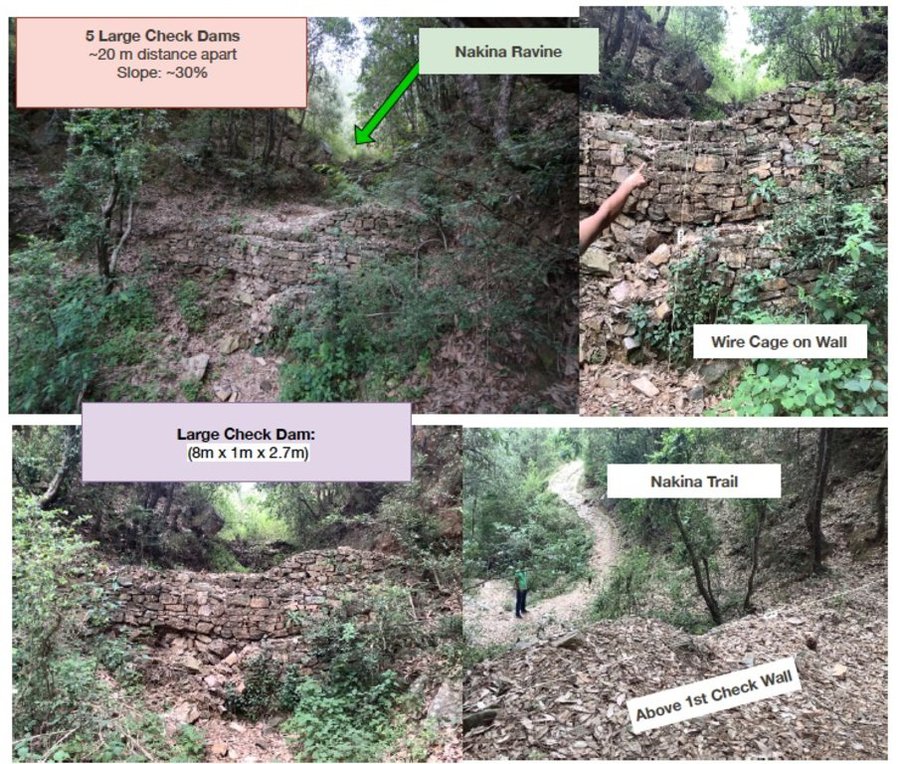
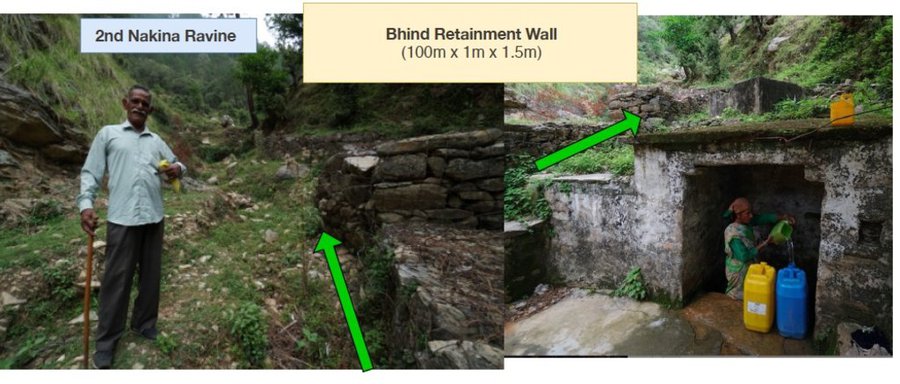
| Опишите затраты | Единица | Количество | Затраты на единицу (INR) | Общая стоимость на единицу (INR) | % затрат, оплаченных землепользователями |
| Оплата труда | |||||
| Large Water Diversion Wall | person-days | 60,0 | 400,0 | 24000,0 | 20,0 |
| 5 Large Check Walls | person-days | 50,0 | 400,0 | 20000,0 | 20,0 |
| Bhind Spring Check Walls/Retainment Wall | person-days | 19,0 | 400,0 | 7600,0 | 50,0 |
| 5 Small Check Walls in Forest | person-days | 10,0 | 400,0 | 4000,0 | 100,0 |
| Оборудование | |||||
| Crate Wire (15m x 2m x 2m) | Cum | 60,0 | 75,0 | 4500,0 | |
| Pick | pieces | 15,0 | 300,0 | 4500,0 | 100,0 |
| Shovel | pieces | 20,0 | 500,0 | 10000,0 | 100,0 |
| pharuwa (hoe) | pieces | 15,0 | 300,0 | 4500,0 | 100,0 |
| khanti (digging bar) | pieces | 10,0 | 1500,0 | 15000,0 | 100,0 |
| hammer (5kg) | pieces | 10,0 | 2000,0 | 20000,0 | 100,0 |
| chino (chisel) | pieces | 10,0 | 500,0 | 5000,0 | 100,0 |
| khukuri (knife) | pieces | 10,0 | 250,0 | 2500,0 | 100,0 |
| Посадочный материал | |||||
| small hammer (0.5-1 kg) | pieces | 15,0 | 300,0 | 4500,0 | 100,0 |
| Строительные материалы | |||||
| Rocks of various size and shape collected/excavated on site | |||||
| Small Check Walls in Forest (5) | cum | 23,625 | 200,0 | 4725,0 | 100,0 |
| Large Check Walls (5) | cum | 108,0 | 200,0 | 21600,0 | 20,0 |
| Large Water Diversion Wall (1) | cum | 71,0 | 200,0 | 14200,0 | 100,0 |
| Bhind Check Walls/Retainment Wall (5) | cum | 150,0 | 200,0 | 30000,0 | 50,0 |
| Другие | |||||
| Rocks of various size and shape collected/excavated on site | |||||
| Общая стоимость запуска Технологии | 196'625.0 | ||||
| Общие затраты на создание Технологии в долларах США | 2'808.93 | ||||
| Опишите затраты | Единица | Количество | Затраты на единицу (INR) | Общая стоимость на единицу (INR) | % затрат, оплаченных землепользователями |
| Оплата труда | |||||
| Reconstruction of damaged check dams | person-days/unit | 10,0 | 400,0 | 4000,0 | 100,0 |
| Removal of sediment | person-days/unit | 5,0 | 400,0 | 2000,0 | 100,0 |
| Оборудование | |||||
| pick | pieces | 3,0 | 70,0 | 210,0 | 100,0 |
| shovel | pieces | 3,0 | 42,0 | 126,0 | 100,0 |
| pharuwa (hoe) | pieces | 2,0 | 52,0 | 104,0 | 100,0 |
| khanti (digging bar) | pieces | 2,0 | 30,0 | 60,0 | 100,0 |
| hammer | pieces | 3,0 | 25,0 | 75,0 | 100,0 |
| chino (chisel) | pieces | 2,0 | 75,0 | 150,0 | 100,0 |
| khukuri (knife) | pieces | 2,0 | 22,0 | 44,0 | 100,0 |
| small hammer (0.5-1kg) | pieces | 3,0 | 120,0 | 360,0 | 100,0 |
| Строительные материалы | |||||
| Stones available at site locally | |||||
| Общая стоимость поддержания Технологии | 7'129.0 | ||||
| Общие затраты на поддержание Технологии в долларах США | 101.84 | ||||
The situation of infrastructure is difficult and inconsistent in the hill regions because of the terrain. The major infrastructural issues are drinking water and irrigation facilities, electricity, transportation and communication facilities and social infrastructure (housing and education). As for financial services, only the State Bank of India (SBI) is active in the hill regions where it is trying to achieve the objective of 100% financial inclusion. Some villages mentioned buying into into agricultural insurance in the past, however this was a temporary enterprise and they were never compensated after extreme climatic events that occurred and damaged over 70% of their crop. Though infrastructure and education has generally improved over the years, institutional and marketing networks in the region aimed at supporting hill-farmers are lacking.
The check dams helped deter the damage from runoff to their settlements and conserved the forest trail that is commonly used to access the areas where fodder/grass collection is permitted.
People have seen the benefits of constructing these structures, and they continue to participate in maintaining and building more check dams to reduce erosion and increase groundwater recharge.